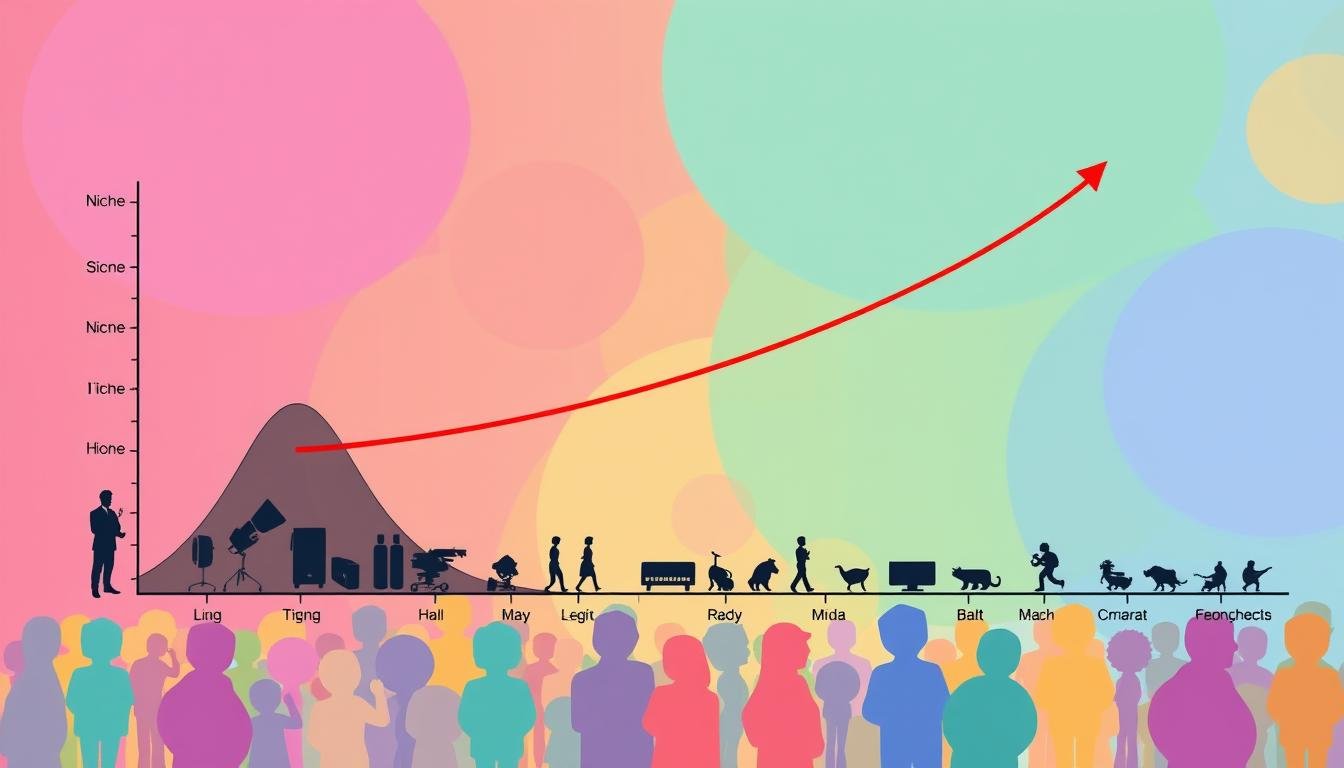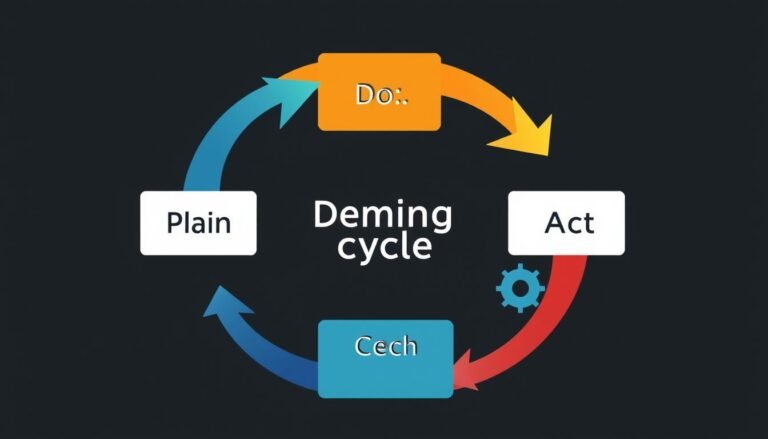Understanding The Long Tail Theory in Marketing
Have you ever thought about why some products you’ve never heard of sell more online than big hits? This mystery is what the Long Tail Theory is all about. It was first talked about by Chris Anderson in 2004. It shows how companies can make a lot of money by focusing on niche markets.
The Long Tail Theory says companies can do well by selling many low-demand products to lots of different people. This new way of thinking makes marketers look into Long Tail SEO. They aim for specific niches that big companies often ignore. With so many movies on Netflix and complex tastes of consumers, it’s key to know how the Long Tail Theory affects marketing and what people want.
Key Takeaways
- The Long Tail Theory focuses on making money from niche markets, not just big hits.
- Online platforms let companies offer more products, meeting diverse consumer tastes.
- Using Long Tail SEO can greatly improve a company’s online presence.
- With more brands out there, marketers need to keep up to stay ahead.
- Knowing what customers want is crucial for a successful Long Tail strategy.
Introduction to The Long Tail Theory
The Long Tail Theory changed how businesses market, especially in digital distribution. Chris Anderson introduced it in 2004. He showed how the market moved from mass-market products to focusing on niche markets.
His 2006 book, “The Long Tail: Why the Future of Business Is Selling Less of More,” explained a key point. He said that the demand for niche items often beats the sales of top hits.
This idea is about the long tail distribution. It shows many people prefer unique products. Companies like Amazon and Netflix used this strategy to offer more variety.
Now, about half of sales come from niche markets, down from 80% for top items. This change is clear as retailers see less revenue from their bestsellers.
Thanks to digital distribution, making and marketing niche products is cheaper. This lets businesses invest in these markets. Search engines help by learning what users like, helping companies offer better products.
This move to niche buying is changing the U.S. economy. It’s leading to a market with more variety and diverse consumer tastes in the 21st century.
The Concept of the Long Tail in Business Strategy
Business strategies have changed from focusing on the mass market to targeting niche markets. This shift means companies now offer a mix of popular and less popular items. It matches what consumers want, as they look for products that fit their unique tastes.
The Shift from Mass-Market to Niche Markets
Thanks to online shopping and digital growth, companies can reach more customers easily. They can sell a variety of products at lower costs, making niche markets easier to enter. While big hits still sell well, especially in media, less popular items are also gaining ground.
Role of Online Marketplaces in Long Tail Strategy
Online stores like Amazon are key to the Long Tail strategy. They use their huge online space to sell many products, helping sellers reach different customers. This shows how online shops beat physical stores in making money, especially with unique items.
Customers can now find special items they might not see in regular stores. This gives them more choices and makes shopping better.
The Long Tail Theory and Consumer Behavior
The Long Tail Theory changes how people shop online. It shows how online shopping is taking over traditional stores. People now look for unique items that match their own style.
Consumer Preferences in Online Shopping
Now, online shopping patterns show a big move to special products over common ones. Customers like to explore niche markets for items that reflect their unique tastes and lifestyles. This means businesses need to change their marketing to meet the needs of these diverse consumers.
The Impact of Infinite Shelf Space on Variety and Demand
Online stores have infinite shelf space, letting them offer a huge variety of products. This leads to a big demand for less popular items that might not have done well in regular stores. Studies show that the demand for these items can be as big as for top sellers. This highlights the importance of managing stock and connecting with customers well.
The Benefits of Applying Long Tail Keyword Strategy
Using a Long Tail keyword strategy helps businesses grow their online presence. It lets marketers focus on specific phrases that are less competitive. This way, they can meet the needs of certain customers better, making it easier to find potential buyers.
Maximizing Online Visibility Through Long Tail SEO
Long Tail SEO boosts a website’s visibility online. Keywords with three to five words are less common but bring in more value because they’re specific. Companies targeting these terms often get more website visitors. This is because it’s easier to rank for these keywords than for broad ones.
For example, the keyword “sushi sandwich recipe” has a Keyword Difficulty of 27%. This makes it easier for marketers to grab the audience’s attention.
Capturing Niche Markets with Long Tail Keywords
Long Tail keywords are key to finding and reaching niche markets. With most songs on a jukebox getting played, there’s a big demand for unique products. By using niche phrases, businesses can show off what makes them special.
This targeted approach draws in the right kind of traffic and leads to more conversions. This is crucial for growing online in today’s digital world.
The Long Tail Theory in Marketing: Examples and Applications
The Long Tail theory has changed how companies market products. Amazon and Netflix show how using the Long Tail model can reach more customers and make them happier. They use a mix of diverse products and smart recommendations to stay ahead in e-commerce.
How Amazon Utilizes the Long Tail Model
Amazon uses the Long Tail model by offering a huge selection of products. While Barnes & Noble has about 100,000 titles in stores, Amazon has around 4-5 million online. This lets customers find unique items they might not find elsewhere.
Amazon’s recommendation algorithms also play a big role in its success. These algorithms look at what customers buy and suggest more of the same. In fact, 57% of Amazon’s book sales come from these long-tail searches. This approach makes shopping on Amazon more personal, helping users find products they like.
Netflix: Long Tail Strategy in Content Recommendations
Netflix uses the Long Tail strategy by mixing popular shows with niche content. It analyzes what users watch and suggests more of the same. This makes watching Netflix better and helps users discover new shows and movies.
From 2001 to 2005, Netflix made a lot of money from niche titles, not just popular ones. This strategy keeps subscribers coming back, like the 45 million who watched “Birdbox.” Netflix’s smart recommendations help it offer something for everyone, keeping viewers happy and loyal.
The Challenges of Long Tail Marketing
Long Tail marketing has its perks, but it also comes with challenges. Marketers need to understand these challenges to use this approach well. It helps them meet the needs of different consumers.
Understanding Demand Concentration
One big challenge is that people often prefer well-known products. This makes niche products less popular. Even adding more products can actually decrease demand overall.
This makes it hard to reach consumers with less popular products. Marketers must know how people behave to succeed.
Balancing Quality and Quantity in Niche Offerings
It’s tough to balance quality and quantity in Long Tail marketing. Companies need to keep their niche products high quality. If they don’t, people won’t trust them.
Expanding too fast without checking quality can hurt your business. Finding the right balance is key. It means managing your inventory well and keeping an eye on quality to please customers and meet your goals.
| Challenge | Description | Impact |
|---|---|---|
| Demand Concentration | Consumers favor popular products over niche items | Reduced sales for less popular products |
| Quality vs. Quantity | Need to maintain high quality while expanding product range | Potential loss of consumer trust |
| Operational Complexity | Challenges in managing diverse inventory efficiently | Higher storage and logistics costs |
| Market Segmentation | Tailoring marketing strategies for niche audiences | Requires more focused resource allocation |
Conclusion
The Long Tail Theory is changing how we market today. It shows the power of focusing on niche markets in our digital world. By understanding what customers want, businesses can make their marketing more precise.
With more online stores, it’s smart to offer a wide range of unique items. Even if each item doesn’t sell much, it adds to the overall variety. Companies like Amazon and Netflix use this strategy to make more money from less popular items.
This way, they can offer more products and still make a profit. By using Long Tail methods in their keyword strategies, brands can be more visible online. This helps them reach the right customers and stand out in a crowded market.
Today, with more choices than ever, the Long Tail Theory is still key. It tells us to give customers what they want, even if it’s something special. By using data to understand what people like, businesses can tailor their marketing. This helps them meet the needs of their customers in a world full of options.
Source Links
- Rethinking the Long Tail Theory: How to Define ‘Hits’ and ‘Niches’
- The Long Tail Theory Can Be Reality for Traditional Megabrands
- Long Tail: Definition as a Business Strategy and How It Works
- Understanding the ‘Long Tail’ Theory in Media, Marketing & E-Commerce
- Should You Invest in the Long Tail?
- What Is The Long Tail And How Can It Benefit Your Business?
- The Long Tail Effect Theory in Practise Explained
- The Long Tail Theory: Promoting Revenue Growth for FMCGs | Revenue AI
- Multichannel Customer Purchase Behavior And Long Tail Effects In The Fashion Goods Market
- Why focus on long tail keywords?
- Long-Tail Keywords: What They Are & How to Use Them in 2024
- The Long Tail Theory, Debunked: We Stick With What We Know
- What Is Long Tail In Marketing? | Long Tail Theory Explained
- Cracking the Long Tail Challenge in E-commerce: Strategies for Success
- Recognize Strategic Opportunities with Long-Tail Data
- No title found
- The Long Tail Economies of the Internet







